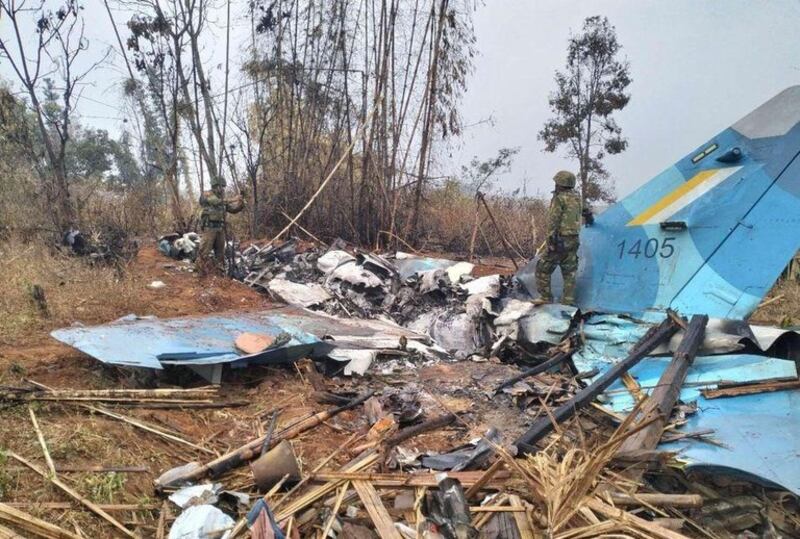An ethnic army has captured the military camp of the junta’s Light Infantry Battalion No. 123 in northern Myanmar’s Shan state, residents and the rebel group said Thursday, capping months of fighting for control of a key trade route with China.
The loss of the base means that ethnic rebels now control the entire 130-kilometer (80-mile) trade route from Muse township on the border with China to Hseni, located some 50 kilometers (30 miles) north of northern Shan state’s largest town of Lashio.
It is also the latest in a number of setbacks for the military since an ethnic offensive in late October that has seen the Three Brotherhood Alliance capture 15 cities in northern Shan state, seize control of more than 200 military camps, and force the surrender of some 4,000 junta troops.
The Kachin Independence Army, or KIA, took control of the camp on Wednesday evening after initially overrunning Nam Hpat Kar town on Jan. 17, KIA spokesman Col. Naw Bu told RFA Burmese.
“We heard that the military camp at Nam Hpat Kar was seized around 3 p.m. or 4 p.m., but we haven’t received any details from the field yet,” he said. “We haven’t been able to get a phone connection through.”
A resident of Nam Hpat Kar who, like others interviewed for this report, spoke on condition of anonymity due to security concerns, told RFA that KIA soldiers entered the military compound on Wednesday, prompting junta troops to flee toward nearby Tarmoenye township.
“I’m sure the KIA troops are now stationed at Light Infantry Battalion No. 123 camp,” he said. “Since the troops retreated toward Tarmoenye, they are following them and clearing them out. The damage to the village is huge.”
Ethnic rebels began attacking Nam Hpat Kar township in late August, but the KIA only started the fight for control of the Light Infantry Battalion camp on Jan. 14. Junta forces responded to attacks on the camp with heavy artillery and airstrikes, residents said.
The KIA claimed on Jan. 16 that it was able to shoot down a junta jet fighter during fighting in the area.
Civilian casualties
Another resident of Nam Hpat Kar, who was forced to leave his home amid the fighting, told RFA that the military airstrikes destroyed area homes and caused civilian casualties.
“The [KIA] also broke into the houses and fired from inside of them, so the military attacked the houses based on information they received,” he said. “At the moment, out of the eight houses I know [were fired on], four were reduced to ashes. The rest of the houses no longer have walls or roofs.”
The resident said at least two civilians were killed in the fighting, but was unable to provide additional details. He said villagers are afraid to return home because of the threat of additional airstrikes.
More than 20,000 people live in Nam Hpat Kar, which consists of four wards and nine village tracts.
Aid workers said that some 10,000 residents of villagers close to the military camp were forced to flee to monasteries in the townships of Namhkan, Muse, Lashio and other nearby areas amid the clashes.
Another resident of Nam Hpat Kar told RFA that, as of Jan. 17, he had documented the deaths of at least 24 civilians due to military airstrikes and artillery fire, and said at least 100 homes had been damaged.

A social worker who fled from Nam Hpat Kar due to the fighting said on Thursday that the number of casualties and extent of the damage had yet to be fully accounted for, due to severed internet and telephone lines.
The junta has not released any statement about the situation in Nam Hpat Kar.
KIA demonstrates importance
A former military officer, who now works as a commentator on military and political issues in Myanmar, said that the capture of the camp in Nam Hpat Kar is a demonstration of the junta’s increasing weakness in the region.
“The attack took 10 days, and we should praise the bravery [of the junta troops] who resisted it,” he said.
But he criticized the military’s leadership for failing to do enough to hold the camp.
“[Nearby] Kutkai and Namhkan [townships were] seized by the [Ta'ang National Liberation Army],” the former officer said, referring to one of the three ethnic armies that, along with the Myanmar National Democratic Alliance Army and the Arakan Army, form the Three Brotherhood Alliance.
“Now, Nam Hpat Kar, which is located at the top of the road heading to Namhkan, has been captured. So now it is all done, and [the KIA] has demonstrated the importance of its role [in fighting the military],” he said.
In the five months of fighting between ethnic armies and the junta for Nam Hpat Kar, more than 50 civilians – including women and children – were killed, according to residents.
Translated by Htin Aung Kyaw. Edited by Joshua Lipes and Matt Reed.
